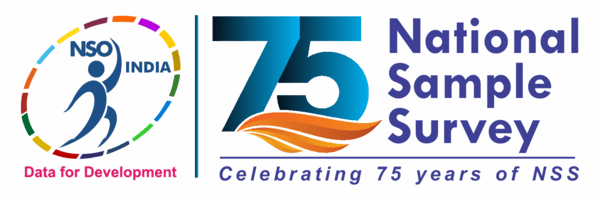DDI-IND-CSO-MIS-78-2020
Multiple Indicator Survey(MIS), NSS 78th Round
| Name |
|---|
| INDIA |
The National Sample Surveys (NSS) are being conducted by the Government of India since 1950 to collect socio-economic data employing scientific sampling methods. Seventyeighth rounds of NSS will commence from 1st January 2020. NSS 78th round is earmarked for collection of data on ‘Domestic Tourism Expenditure and ‘Multiple Indicators’. Survey on Multiple Indicators is being conducted for the first time in NSS during this round.
The objective of Multiple Indicator Survey (MIS) is to collect information for developing some important indicators of Sustainable Development Goals 2030. In formation on (i) Migration and (ii)Construction of houses since 2014-15 will also be collected through MIS as per the request of M/o HUA. In addition to these, information on access to mass media, availability of birth registration certificate will be collected in MIS.
Randomly selected households based on sampling procedure and members of the household.
2020
The survey will cover the whole of the Indian Union except the villages in Andaman and Nicobar Islands which are difficult to access.
The survey used the interview method of data collection from a sample of randomly selected households and members of the household.
| Name | Affiliation |
|---|---|
| NSSO | MoSPI |
| Name | Affiliation |
|---|---|
| COMPUTER CENTRE | M/o STATISTICS & PROGRAMME IMPLEMENTATION |
| Name |
|---|
| M/o STATISTICS & PROGRAMME IMPLEMENTATION |
Sample Design
Formation of sub-units (SUs):
Rural areas: A rural village will be notionally divided into a number of sub-units (SU)
of more or less equal population during the preparation of frame. Census 2011 population of
villages will be projected by applying suitable growth rates and the number of SUs to be
formed in a village will be determined apriori.
The above procedure of SU formation will be implemented in the villages with
population more than or equal to 1000 as per Census 2011. In the remaining villages, no SU
will be formed.
The number of SUs to be formed in the villages (with Census 2011 population 1000 or
more) of the frame will be decided before selection of the samples following the criteria given
below:
projected population of the village no. of SUs to be formed
less than 1200 1
1200 to 2399 2
2400 to 3599 3
3600 to 4799 4
4800 to 5999 5
.......and so on ....
Special case:
For rural areas of (i) Himachal Pradesh, (ii) Sikkim, (iii) Andaman & Nicobar
Islands, (iv) Uttarakhand (except four districts Dehradun, Nainital, Hardwar and Udham Singh
Nagar), (v) Punch, Rajouri, Udhampur, Reasi, Doda, Kishtwar, Ramban of Jammu and
Kashmir (vi) Leh and Kargil districts of Ladakh region and (vii) Idukki district of Kerala,
numbers of SUs to be formed in a village will be determined in such a way that each SU
contains 600 or less projected population. Further, SUs will not be formed in the villages in
the above mentioned districts/States with population less than 500 as per Census 2011. In the
remaining villages the number of SUs to be formed for these States/districts will be as follows:
projected population of the village no. of SUs to be formed
less than 600 1
600 to 1199 2
1200 to 1799 3
1800 to 2399 4
2400 to 2999 5
.......and so on ....
Urban areas: SUs will be formed in urban sector also. The procedure will be similar
to that adopted in rural areas except that SUs will be formed on the basis of households in the UFS frame instead of population, since UFS frame does not have population. Each UFS block with number of households more than or equal to 250 will be divided into a number of SUs. In the remaining UFS blocks, no SU will be formed.
The number of SUs to be formed in the UFS blocks of the frame will be decided before
selection of the samples following the criteria given below:
number of households of the UFS block no. of SUs to be formed
less than 250 1
250 to 499 2
500 to 749 3
750 to 999 4
1000 to 1249 5
.......and so on ....
Stratification of FSUs:
(a) Each district will be a stratum. Within each district of a State/UT, generally speaking,
two basic strata will be formed: (i) rural stratum comprising of all rural areas of the
district and (ii) urban stratum comprising of all the urban areas of the district.
However, within the urban areas of a district, if there are one or more towns with
population one million or more as per Census 2011, each of them will form a separate
basic stratum and the remaining urban areas of the district will be considered as
another basic stratum.
(b) A special stratum, in the rural areas only, will be formed at all-India level before
district level strata are formed in each State/UT. This stratum will comprise all the
uninhabited villages as per Census 2011 belonging to all States/UTs.
Allocation of State/UT level sample to rural and urban sectors: State/UT level sample size will be allocated between two sectors in proportion to population as per Census 2011 with 1.5 weightage to urban sector. A minimum of 4 FSUs, each for rural and urban
sector separately, will be allocated to each State/UT. For more urbanised big States like Maharashtra, Tamil Nadu etc., the urban allocation will be limited to rural sample size to avoid undue weightage to urban sector.
DDI-IND-CSO-MIS-78-2020
| Name | Affiliation | Role |
|---|---|---|
| COMPUTER CENTRE | M/o STATISTICS & PROGRAMME IMPLEMENTATION | DOCUMENTATION OF THE STUDY |
2020

